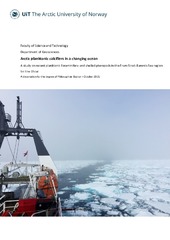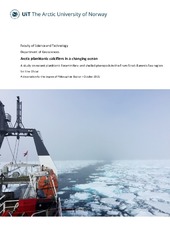| dc.contributor.advisor | Rasmussen, Tine Lander | |
| dc.contributor.author | Ofstad, Siri | |
| dc.date.accessioned | 2021-12-02T11:34:40Z | |
| dc.date.available | 2021-12-02T11:34:40Z | |
| dc.date.issued | 2021-12-16 | |
| dc.description.abstract | The Arctic marine realm is being transformed due to the anthropogenically-induced climate change. In the Arctic, the effects of climate change are intensified due to polar amplification and have led to processes in the ocean such as sea-ice retreat, ocean acidification and the increased presence of boreal species referred to as ‘Atlantification’. This thesis presents rare investigations of marine calcifiers in the Fram Strait-Barents Sea region; planktonic foraminifera (Phylum Retaria) and the shelled pteropod <i>Limacina helicina</i> (Phylum Mollusca). There are few previous studies signifying several unknowns pertaining to their ecology and life cycles, and hence how they have and will continue to respond to climate change. The overarching aim of the thesis is to increase the knowledge of living planktonic foraminifera and pteropods in the Arctic, more specifically their distribution patterns, absolute and relative abundance, seasonality, diversity, ontogeny, and calcification. These studies are based on investigations from two dynamic areas; the Bjørnøyrenna Craters in the northern Barents Sea that is a site of intense methane seepage, and the Northeast Greenland Shelf where there is a rapid sea-ice reduction and interplay between Polar and Atlantic water masses. This thesis has shown that the Fram Strait-Barents Sea region is characterized by low species diversity of the planktonic foraminiferal faunas, where <i>Neogloboquadrina pachyderma</i> dominates in Polar Water and <i>Turborotalita quinqueloba</i> dominates in Atlantic Water. Our study areas have low standing stock of both planktonic foraminifera and pteropods in spring and a medium to high standing stock in summer. They have a distinct vertical shell density gradient and are not affected by intense methane seepage even in the relatively shallow Barents Sea. In terms recent impact of climate, there may be a decrease in the relative abundance of <i>N. pachyderma</i> on the Northeast Greenland shelf compared to studies from the 1990s, and sub-tropical species can be found in the Barents Sea. Furthermore, this thesis has helped in filling gaps in research into the impacts of ocean acidification in the Arctic, especially pertaining to methane release from dissociation of methane hydrates. Lastly, we have been able to show that planktonic foraminifera and pteropods in the same size class captured from the same location and depth interval have a wide range of shell densities. The same is also true for planktonic foraminifera found in surface sediments. These two points may complicate modern geochemical or ocean acidification studies as well as paleo-studies. | en_US |
| dc.description.doctoraltype | ph.d. | en_US |
| dc.description.popularabstract | The Arctic is changing. Small organisms (planktonic foraminifera and shelled pteropods) in the water column were studied in terms of their abundance, seasonality, diversity, life cycles, and calcification. This was done by collecting samples with a plankton net and collecting water and surface sediments. This thesis has shown that the Fram Strait-Barents Sea region is characterized by low species diversity and marked seasonality. We found a decrease in the relative abundance of the polar species N. pachyderma on the Greenland shelf compared to the 1990s, and sub-tropical species in the Barents Sea. This thesis has helped in filling gaps in research into the impacts of ocean acidification in the Arctic. Lastly, we have been able to show that organisms in the same size class and water depth have a wide range of shell densities which is also true for foraminifera in surface sediments. These two points may complicate geochemical or ocean acidification studies as well as paleo-studies. | en_US |
| dc.description.sponsorship | This work was supported by the Centre for Arctic Gas Hydrate, Environment and Climate (CAGE), the Research Council of Norway through its Centres of Excellence scheme (grant 223259). | en_US |
| dc.identifier.isbn | 978-82-8236-463-8 (pdf) | |
| dc.identifier.uri | https://hdl.handle.net/10037/23247 | |
| dc.language.iso | eng | en_US |
| dc.publisher | UiT Norges arktiske universitet | en_US |
| dc.publisher | UiT The Arctic University of Norway | en_US |
| dc.relation.haspart | <p>Paper I: Ofstad, S., Meilland, J., Zamelczyk, K., Chierici, M., Fransson, A. & Rasmussen, T.L. (2020). Development, productivity, and seasonality of living planktonic foraminiferal faunas and <i>Limacina helicina</i> in an area of intense methane seepage in the Barents Sea. <i>Journal of Geophysical Research: Biogeosciences, 125</i>(2), e2019JG005387. Also available in Munin at <a href=https://hdl.handle.net/10037/17522>https://hdl.handle.net/10037/17522</a>.
<p>Paper II: Ofstad, S., Zamelczyk, K., Kimoto, K., Chierici, M., Fransson, A. & Rasmussen, T.L. (2021). Shell density of planktonic foraminifera and pteropod species <i>Limacina helicina</i> in the Barents Sea: Relation to ontogeny and water chemistry. <i>PLOS One, 16</i>(4), e0249178. Also available in Munin at <a href=https://hdl.handle.net/10037/21744>https://hdl.handle.net/10037/21744</a>.
<p>Paper III: Ofstad, S., Meilland, J., Rasmussen, T. L., Zamelczyk, K. & Seidenkrantz, M.S. Northeast Greenland planktonic foraminiferal fauna: present distribution patterns and paleoperspectives. (Submitted manuscript). | en_US |
| dc.relation.isbasedon | <p>Data related to Paper I:
<p>Ofstad, S. (2019). Abundance of living planktonic foraminifera and <i>Limacina helicina</i> in the Barents Sea. PANGAEA, <a href=https://doi.pangaea.de/10.1594/PANGAEA.904463>https://doi.pangaea.de/10.1594/PANGAEA.904463</a>.
<p>Chierici, M., Fransson, A. & Lødmel, H.H. (2020). The marine CO<sub>2</sub> system in the Barents Sea crater area in April and June 2016. Norwegian Marine Data Center, <a href=https://doi.org/10.21335/NMDC-225800978>https://doi.org/10.21335/NMDC-225800978</a>. | en_US |
| dc.relation.projectID | info:eu-repo/grantAgreement/RCN/SFF/223259/Norway/Centre for Arctic Gas Hydrate, Environment and Climate/CAGE/ | en_US |
| dc.rights.accessRights | openAccess | en_US |
| dc.rights.holder | Copyright 2021 The Author(s) | |
| dc.subject.courseID | DOKTOR-004 | |
| dc.subject | VDP::Mathematics and natural science: 400::Geosciences: 450::Oceanography: 452 | en_US |
| dc.subject | VDP::Matematikk og Naturvitenskap: 400::Geofag: 450::Oseanografi: 452 | en_US |
| dc.subject | VDP::Mathematics and natural science: 400::Zoology and botany: 480::Marine biology: 497 | en_US |
| dc.subject | VDP::Matematikk og Naturvitenskap: 400::Zoologiske og botaniske fag: 480::Marinbiologi: 497 | en_US |
| dc.title | Arctic planktonic calcifiers in a changing ocean - A study on recent planktonic foraminifera and shelled pteropods in the Fram Strait-Barents Sea region | en_US |
| dc.type | Doctoral thesis | en_US |
| dc.type | Doktorgradsavhandling | en_US |


 English
English norsk
norsk
